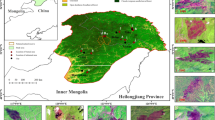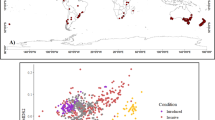Abstract
Introduction
The aims of this study were to identify the climatic conditions controlling the distribution of Sasamorpha borealis and to assess the impact of climate change on the species in Japan.
Materials and methods
The relationship between S. borealis distribution and climatic variables in the Japanese Archipelago was explored using classification tree analysis. Potential habitat maps under the current and future climates were generated at about 1-km spatial resolution.
Results
The model was highly accurate. Although snow cover has been thought to be the most important factor controlling S. borealis distribution, we revealed that the species requires high precipitation during the growing season even in humid Japanese environments. Areas with high summer (May–September) precipitation (PRS) were classified as potential habitat irrespective of other climatic conditions. In areas with moderate PRS, potential habitat was limited to cooler and less snow-covered areas and areas with low PRS were classified as non-habitat. The high fitness of the predicted to the observed distributions suggested that S. borealis could have survived throughout the Japanese Archipelago during the glacial period.
Conclusion
In future climates, 29.0–39.1% of the current potential habitat was predicted to change to non-habitat due to increasing dryness in the growing season. Areas with high precipitation remained a potential habitat for S. borealis.





Similar content being viewed by others
References
Archaux F, Wolters V (2006) Impact of summer drought on forest biodiversity: what do we know? Ann For Sci 63:645–652
Begon M, Harper J, Townsend C (1996) Ecology: individuals, populations and communities, 3rd edn. Blackwell Science, Oxford, 1068 p
Clark L, Pregibon D (1992) Tree-based models. In: Chambers J, Hastie T (eds) Statistical Models in S. Wadsworth & Brooks/Cole, California, pp 377–419
Hannah L, Midgley G, Millar D (2002) Climate change-integrated conservation strategies. Glob Ecol Biogeogr 11:485–495
Hino T (2006) The impact of herbivory by deer on forest bird communities in Japan. Acta Zool Sin 52:684–686
IPCC (2007) Climate change 2007: the physical science basis. Contribution of Working Group I to the Fourth Assessment Report of the Intergovernmental Panel on Climate Change. Cambridge University Press, Cambridge, 996 p
Japan Meteorological Agency (1996) Climatic normals for Japan. Japan Meteorological Business Support Center, Tokyo (In Japanese)
Japan Meteorological Agency (2004) MRI-RCM20. Global Environment and Marine Department of Japan Meteorological Agency, Tokyo (In Japanese)
K-1 Model Developers (2004) K-1 coupled GCM (MIROC) description. K-1 Tech Rep 1:1–34
Kira T (1991) Forest ecosystems of east and southeast Asia in a global perspective. Ecol Res 6:185–200
Kominami Y, Tanaka N, Endo Y, Niwano S (2005) Estimation of snow distribution under global warming using data from remote weather stations (AMeDAS). J Agric Meteorol 60:445–450
Matsui T, Yagihashi T, Nakaya T, Tanaka N, Taoda H (2004) Climatic controls on distribution of Fagus crenata forests in Japan. J Veg Sci 15:57–66
Metz C (1978) Basic principles of ROC analysis. Semin Nucl Med 8:283–298
Morin X, Thuiller W (2009) Comparing niche- and process-based models to reduce prediction uncertainty in species range shifts under climate change. Ecology 90:1301–1313
Nakashizuka T (1987) Regeneration dynamics of beech forests in Japan. Vegetatio 69:169–175
Ohsawa M (1993) Latitudinal pattern of mountain vegetation zonation in southern and eastern Asia. J Veg Sci 4:13–18
Parmesan C, Yohe G (2003) A globally coherent fingerprint of climate change impacts across natural systems. Nature 421:37–42
Pearson RG, Dawson TP (2003) Predicting the impacts of climate change on the distribution of species: are bioclimate envelope models useful? Global Ecol Biogeogr 12:361–371
Pearson RG, Dawson TP, Liu C (2004) Modelling species distributions in Britain: a hierarchical integration of climate and land-cover data. Ecography 27:285–298
Saruki S, Inoue S, Shiiba Y, Nagasawa H, Ohosaki S, Kubota K (2004) Distribution and growth situation of Suzutake (Sasamorpha borealis) damaged by grazing of Sika deer (Cervus nippon nippon) in Miyazaki Forest of Kyushu University: case study in 2003. Bull Kyushu Univ For 85:47–54 (In Japanese with English summary)
Suzuki S (1961) Ecology of the Bambusaceous genera Sasa and Sasamorpha in the Kanto and Tohoku districts of Japan, with special reference to their geographical distribution. Ecol Rev 15:131–147
Suzuki S (1978) Index to Japanese Bambusaceae. Gakken, Tokyo, p 384 (In Japanese)
Swets J (1988) Measuring the accuracy of diagnostic systems. Science 240:1285–1293
Tanaka N (2007) PRDB (Phytosociological Relevé Data Base). Available from: http://www.ffpri.affrc.go.jp/labs/prdb/index.html. Accessed June 2008
Thuiller W, Lavorel S, Araújo M, Sykes M, Prentice I (2005) Climate change threats to plant diversity in Europe. Proc Natl Acad Sci USA 102:8245–8250
Tsuyama I, Matsui T, Horikawa M, Kominami Y, Tanaka N (2008a) Habitat prediction and impact assessment of climate change on dwarf bamboo of the section Sasa in Japan. Theory Appl GIS 16:99–113 (In Japanese with English summary)
Tsuyama I, Matsui T, Ogawa M, Kominami Y, Tanaka N (2008b) Habitat prediction and impact assessment of climate change on Sasa kurilensis in eastern Honshu, Japan. Theory Appl GIS 16:11–25 (In Japanese with English summary)
Woodward F (1996) Climate and plant distribution. Cambridge University Press, Cambridge, 188 p
Yokozawa M, Goto S, Hayashi Y, Seino H (2003) Mesh climate change data for evaluating climate change impacts in Japan under gradually increasing atmospheric CO2 concentration. J Agric Meteorol 59:117–130
Yuruki T, Aragami K, Inoue S (1977) Ecological studies of Suzutake (Sasa borealis). Bull Kyushu Univ For 50:83–122 (In Japanese with English summary)
Acknowledgments
We thank Dr. Erin Conlisk for her useful comments and language help on this manuscript. We also thank the anonymous reviewer and the associate editor Gilbert Aussenac for their valuable comments. This study was funded by a program of the Global Environmental Research of Japan (S-4 and S-8), the Ministry of the Environment.
Author information
Authors and Affiliations
Corresponding author
Additional information
Handling Editor: Gilbert Aussenac
Electronic supplementary materials
Below is the link to the electronic supplementary material.
Fig. S1
The study area, including names of important regions of Japan (PDF 257 kb)
Fig. S2
Distributions of S. borealis based on the SDD generated from Suzuki (1978). Black boxes indicate the presence of S. borealis. The spatial resolution is about 10 km (PDF 112 kb)
Fig. S3
Spatial distributions of the five climatic variables under a the current climate, b the RCM20 scenario (2081–2100), and c the MIROC scenario (2081–2100). WI warmth index (Kira 1991), TMC temperature of the coldest month, PRS summer (May–September) precipitation, MSW maximum snow water equivalent, WR winter (November–April) rainfall (PDF 212 kb)
Fig. S4
Changes in habitat types under the two climatic change scenarios; i.e., a the RCM20 scenario and b the MIROC scenario. “Suitable” in the legend refers to suitable habitat, “Marginal” indicates marginal habitat, and “Non” means non-habitat (PDF 227 kb)
Rights and permissions
About this article
Cite this article
Tsuyama, I., Nakao, K., Matsui, T. et al. Climatic controls of a keystone understory species, Sasamorpha borealis, and an impact assessment of climate change in Japan. Annals of Forest Science 68, 689–699 (2011). https://doi.org/10.1007/s13595-011-0086-y
Received:
Accepted:
Published:
Issue Date:
DOI: https://doi.org/10.1007/s13595-011-0086-y




